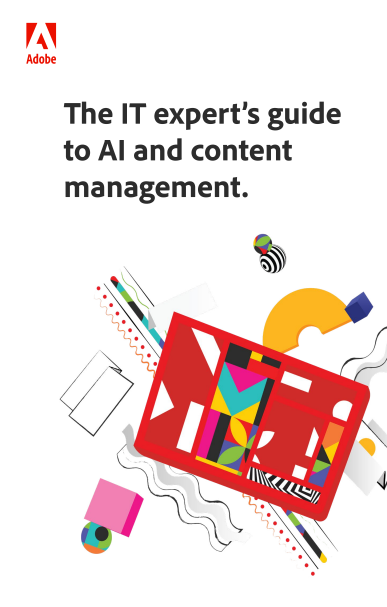Augmented reality’s making a comeback – but did it ever actually leave?
With new consumer AR products on the horizon, the hype around this technology is building again. But in the enterprise sector, it's already found its niches


Back in 2014, augmented reality (AR) was generating a huge buzz thanks to the consumer release of Google Glass; smart glasses that made everyone think we were entering some futuristic new era of a kind only ever seen in Minority Report. Sadly, however, that world was not to be and the biggest thing to come out of AR since then is Pokémon Go!.
Or is it?
AR might not have achieved critical mass in the consumer realm (beyond the gaming niche), but it was quietly embraced by industry, where demand has gradually but steadily grown.
RELATED RESOURCE

The IT expert’s guide to AI and content management
How artificial intelligence and machine learning could be critical to your business
AR in the enterprise
The enterprise AR space has been maturing for several years, with initial investment and adoption beginning notably in 2015. Microsoft’s original HoloLens helped spur significant interest and remains a market leader and recent analysis by PwC has identified at least 1,300 unique examples of commercial AR usage in the UK and US.
“In enterprise it’s been worker and remote enablement that’s driven the AR market,” says Eric Abbruzzese, research director at ABI Research. “Remote assistance and training are consistently the top two use cases. [These offer] increased worker efficiency, and reduced downtime and travel. Integrating the worker with existing systems also adds value – for example having worker input through an AR device feed directly into an internet of things (IoT) platform and auto-update data, which can then be pushed to all workers.”
Interest from industry has grown exponentially in the last 18 months due to COVID-19, as remote working became a requirement rather than a nice to have. Not all of this converted to adoption immediately, but that interest is only strengthening even as the pandemic begins to wane, Abbruzzese notes.
Where are the compelling consumer products?
The consumer market has been a different story. There’s not yet been a compelling consumer smart glasses product and although efforts around mobile device AR have proven successful, they’ve not become ubiquitous.
Get the ITPro daily newsletter
Sign up today and you will receive a free copy of our Future Focus 2025 report - the leading guidance on AI, cybersecurity and other IT challenges as per 700+ senior executives
This looks set to change however. After years of quiet AR and virtual reality (VR) investment behind the scenes, the big tech firms are now starting to bring their solutions out of the shadows.
“AR never left, but the consumer market is showing renewed interest because some of the tech giants – the Apples, Microsofts, Facebooks – are making waves with their rumoured announcements,” says Tuong Nguyen, senior principal analyst at Gartner.
“There’s so much buzz out there right now; funding, patent, acquisition announcements. At its 2021 Worldwide Developer Conference, Apple made a bunch of AR announcements without actually saying those words – but you have to pay attention and connect the dots.
“I personally wouldn’t want to use the term AR because it’s been around for such a long time and there’s a lot of baggage and expectations attached to it. However, the fact is we’ve reached a point where certain elements make mature AR solutions possible. Things have been going on behind the curtains, but it’s when everything’s revealed that the audience gets excited.”
Apple is rumoured to be launching an immersive head-mounted device (HMD) in 2022 and a see-through AR device in 2023. Abbruzzese expects the HMD to be similar to current VR headsets like the Oculus Quest, while the AR device is more open in terms of capabilities and form. “Either way it will almost certainly tether to an iOS device and fulfil a similar role to the Apple Watch today.
“Microsoft has HoloLens and is building out greater AR compatibility and capability in other products like Teams and Azure,” he continues, “while Facebook has Reality Labs, with confirmed a product coming this year and similarly has content and platform partnerships already. Snap also has an upcoming product and acquired display maker WaveOptics.”
AR set to capture consumer imaginations – yet again
Analysts expect products like AR glasses to capture the imagination of consumers over the coming years, with CCS Insight predicting many major consumer brands, including Samsung, to have staked their claims in this area by 2023. It forecasts sales of 15 million such devices in 2025, ramping up in a way similar to other recent technologies. Smart watches, for example, went from less than 1 million units to more than 25 million in just three years.
There are challenges ahead regarding AI adoption – for example, Jeremy Dalton, author and head of XR (extended reality) at PwC, points out that high-end enterprise headsets continue to be very expensive to produce and buy, while on the consumer front there’s currently a limited amount of content available.
On the flipside, Dalton believes AR has strong growth prospects in both the consumer and enterprise markets, and there are some exciting advancements that will help push uptake.
“In addition to advancements in camera-based scanning technology, LiDAR – depth-sensing laser scanning technology – has led to AR becoming even more powerful in the hands of consumers. It’s no longer confined to simply displaying an image on top of a video feed of the real world: Virtual objects act like real ones, appearing anchored to surfaces in the physical world around you.
“And AR has become easier to access,” Dalton continues. “Through webAR, you can do so via your phone’s web browser without even needing to download any software, reducing the friction that was previously there when engaging with the technology.”
Getting ahead of the curve
Forward thinking companies are now trying to get ahead of the curve by researching how AR could support their business and/or business offerings in the future.
Presentation design agency BrightCarbon, for example, recently gave Oculus Quest 2 headsets to each of their 80 staff to enable them to start thinking about how AR and VR tech could work in the events and presentation industry.
“One of our agency’s major growth areas is training, particularly just-in-time and e-learning, and I think this is an area where AR could really come into its own,” says principal consultant John Bevan. “We gifted staff with these headsets partly as a thank you for keeping motivated during the lockdowns but also to see what we can do with the technology and who’s interested in taking it forward. We’ve got so many creative people across the company, from instructional designers through to messaging and visualisation consultants and from the moment we started trying out the VR/AR experience we began thinking of ways it could be used.
“For me it was just exciting to unleash this technology across the business, see what ideas come up, build some prototypes and try things out. This way, we’re ahead of the curve and when our enterprise-level customers start embracing AR and want something built, we’ll be ready to give them a solid offering,” he concludes.
Keri Allan is a freelancer with 20 years of experience writing about technology and has written for publications including the Guardian, the Sunday Times, CIO, E&T and Arabian Computer News. She specialises in areas including the cloud, IoT, AI, machine learning and digital transformation.
-
 Bigger salaries, more burnout: Is the CISO role in crisis?
Bigger salaries, more burnout: Is the CISO role in crisis?In-depth CISOs are more stressed than ever before – but why is this and what can be done?
By Kate O'Flaherty Published
-
 Cheap cyber crime kits can be bought on the dark web for less than $25
Cheap cyber crime kits can be bought on the dark web for less than $25News Research from NordVPN shows phishing kits are now widely available on the dark web and via messaging apps like Telegram, and are often selling for less than $25.
By Emma Woollacott Published